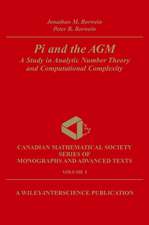Applications of Number Theory to Numerical Analysis
Autor L. K. Hua, Y. Wangen Limba Engleză Paperback – 15 noi 2011
Preț: 388.13 lei
Nou
Puncte Express: 582
Preț estimativ în valută:
74.27€ • 77.90$ • 61.83£
74.27€ • 77.90$ • 61.83£
Carte tipărită la comandă
Livrare economică 01-15 aprilie
Preluare comenzi: 021 569.72.76
Specificații
ISBN-13: 9783642678318
ISBN-10: 3642678319
Pagini: 260
Ilustrații: X, 244 p.
Dimensiuni: 170 x 244 x 14 mm
Greutate: 0.42 kg
Ediția:Softcover reprint of the original 1st ed. 1981
Editura: Springer Berlin, Heidelberg
Colecția Springer
Locul publicării:Berlin, Heidelberg, Germany
ISBN-10: 3642678319
Pagini: 260
Ilustrații: X, 244 p.
Dimensiuni: 170 x 244 x 14 mm
Greutate: 0.42 kg
Ediția:Softcover reprint of the original 1st ed. 1981
Editura: Springer Berlin, Heidelberg
Colecția Springer
Locul publicării:Berlin, Heidelberg, Germany
Public țintă
ResearchCuprins
1. Algebraic Number Fields and Rational Approximation.- §1.1. The units of algebraic number fields.- §1.2. The simultaneous Biophantine approximation of an integral basis.- §1.3. The real eyelotomie field.- §1.4. The units of a eyelotomie field.- §1.5. Continuation.- §1.6. The Drriehlet field.- §1.7. The cubic field.- Notes.- 2. Recurrence Relations and Rational Approximation.- §2.1. The recurrence formula for the elementary symmetric fonction.- §2.2. The generalization of Sn.- §2.3. PV numbers.- § 2.4. The roots of the equation F(x) = 0.- §2.5. The roots of the equation G(x) = 0.- §2.6. The roots of the equation E(x) = 0.- §2.7. The irreducibility of a polynomial.- §2.8. The rational approximations of ?, ?, ?.- Notes.- 3. Uniform Distribution.- §3.1. Uniform distribution.- §3.2. Vinogradov’s lemma.- §3.3. The exponential sum and the discrepancy.- §3.4. The number of solutions to the congruence.- §3.5. The solutions of the congruence and the discrepancy.- §3.6. The partial summation formula.- §3.7. The comparison of discrepancies.- §3.8. Eational approximation and the solutions of the congruence.- §3.9. The rational approximation and the discrepancy.- §3.10. The lower estimate of discrepancy.- Notes.- 4. Estimation of Discrepancy.- §4.1. The set of equi-distribution.- §4.2. The Halton theorem.- §4.3. The p set.- §4.4. The gp set.- §4.5. The eonstruetion of good points.- §4.6. The ?s set.- §4.7. The ? set.- §4.8. The ease s = 2.- §4.9. The glp set.- Notes.- 5. Uniform Distribution and Numerical Integration.- §5.1. The function of bounded variation.- §5.2. Uniform distribution and numerical integration.- §5.3. The lower estimation for the error term of quadrature formula.- §5.4. The quadrature formulas.- Notes.- 6. PeriodicFunctions.- §6.1. The classes of functions.- §6.2. Several lemmas.- §6.3. The relations between Hs?(C), Qs?(C) and Es?(C).- §6.4. Periodic functions.- § 6.5. Continuation.- Notes.- 7. Numerical Integration of Periodic Functions.- §7.1. The set of equi-distribution and numerical integration.- §7.2. The p set and numerical integration.- §7.3. The gp set and numerical integration.- §7.4. The lower estimation of the error term for the quadrature formula.- §7.5. The solutions of congruences and numerical integration.- §7.6. The glp set and numerical integration.- §7.7. The Sarygin theorem.- §7.8. The mean error of the quadrature formula.- §7.9. Continuation.- Notes.- 8. Numerical Error for Quadrature Formula.- §8.1. The numerical error.- §8.2. The comparison of good points.- §8.3. The computation of the ? set.- §8.4. The computation of the ?s set.- §8.5. Examples of other F s sets.- §8.6. The computation of a glp set.- §8.7. Several remarks.- §8.8. Tables.- § 8.9. Some examples.- Notes.- 9. Interpolation.- §9.1. Introduction.- §9.2. The set of equi-distribution and interpolation.- §9.3. Several lemmas.- §9.4. The approximate formula of the function of E?s(C).- §9.5. The approximate formula of the function of Q?s(C).- §9.6. The Bernoulli polynomial and the approximate polynomial.- §9.7. The ? results.- Notes.- 10. Approximate Solution of Integral Equations and Differential Equations.- §10.1. Several lemmas.- § 10.2. The approximate solution of the Fredholm integral equation of second type.- § 10.3. The approximate solution of the Volterra integral equation of second type.- §10.4. The eigenvalue and eigenfunction of the Fredholm equation.- § 10.5. The Cauehy problem of the partial differential equation of the parabolic type.- §10.6. The Diriehlet problem of the partial differential equation of the elliptic type.- § 10.7. Several remarks.- Notes.- Appendix Tables.














